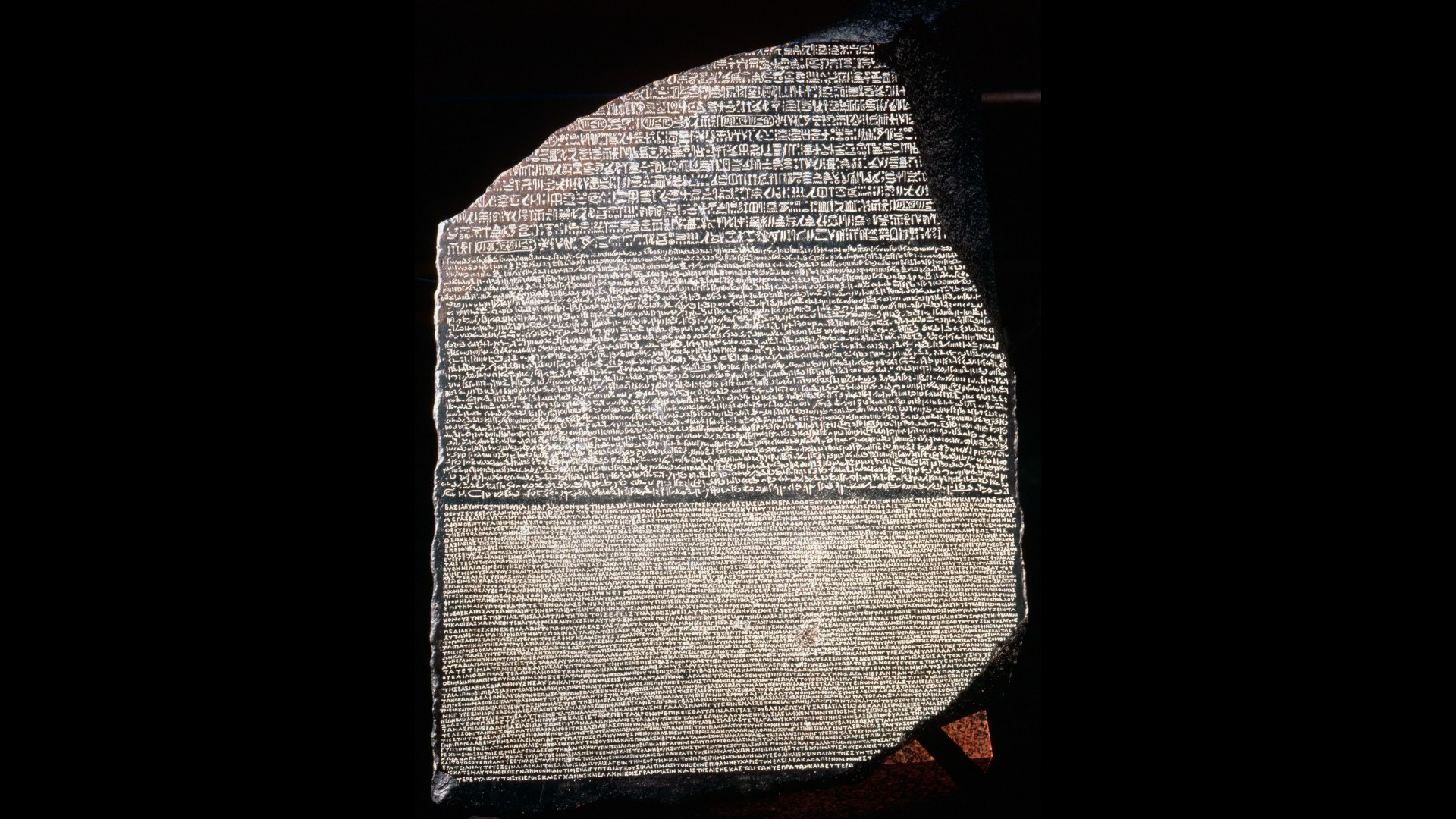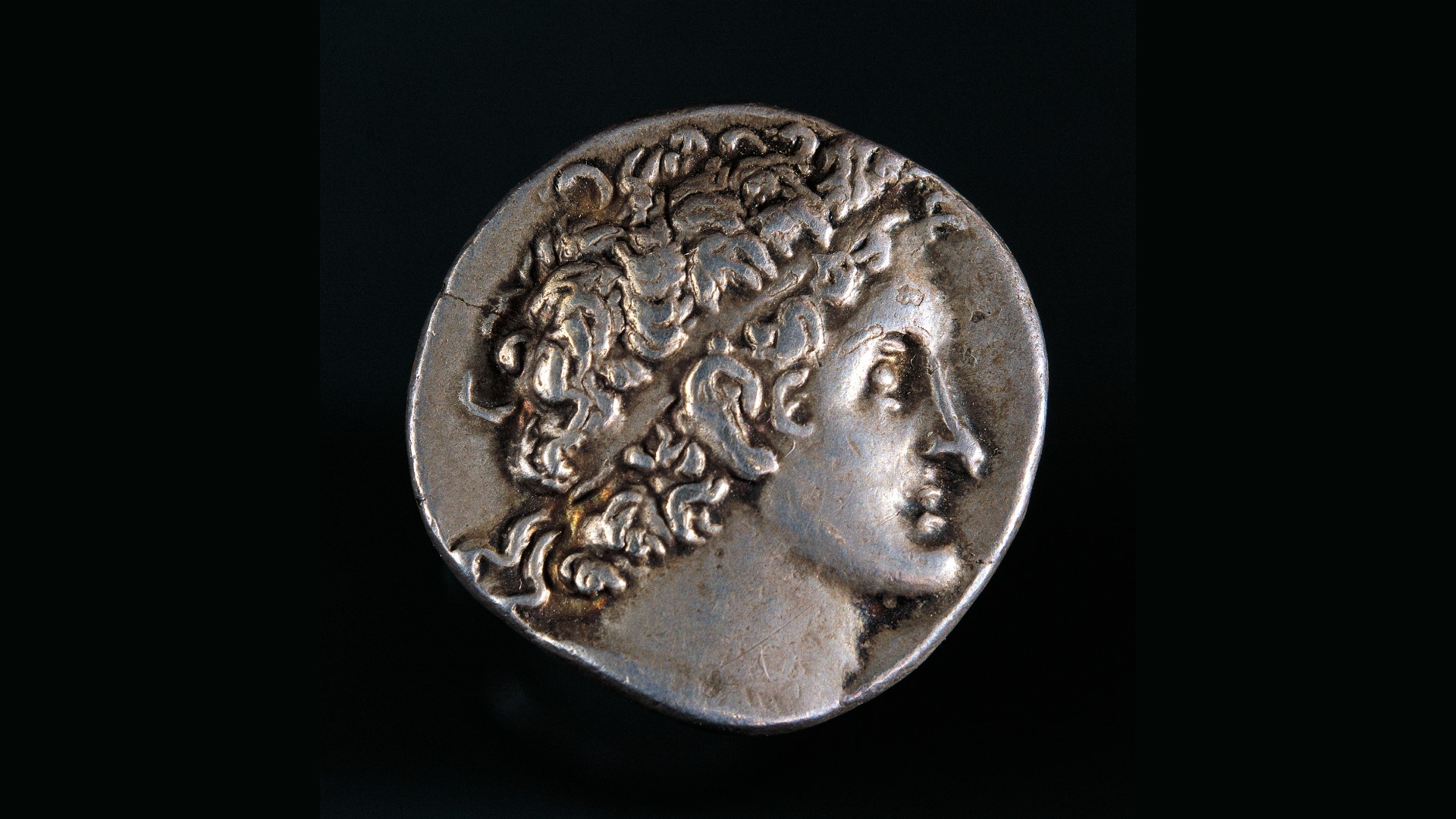
Why does the Rosetta Stone have 3 kinds of writing?
Two of the texts are different scripts for the same language.

The famous Rosetta Stone is a black granite slab inscribed with three ancient texts — two Egyptian and one Greek. It ultimately helped researchers decipher ancient Egyptian hieroglyphics, whose meaning had eluded historians for centuries. But why did ancient scribes include three different kinds of writing, or scripts, on this iconic stone in the first place?
The reason the stone has a trio of scripts ultimately stems from the legacy of one of Alexander the Great's generals. The Greek text on the stone is linked with Egypt's Ptolemaic dynasty, founded by Ptolemy I Soter, a Greek-speaking Macedonian general of Alexander’s. Alexander conquered Egypt in 332 B.C., and Ptolomy I Soter seized control of the country nine years later following Alexander's death. (Cleopatra, who died in 30 B.C., was the last active ruler of the Ptolemaic line.)
The stone isn't associated with Ptolemy I Soter, but with his descendant Ptolemy V Epiphanes, whose priests had the inscribed message composed in three different scripts that each played important social roles during the Ptolemaic dynasty.
Related: How do we decipher Egyptian hieroglyphics and other ancient languages?
A French military expedition that was part of Napoleon's invasion of Egypt unearthed the Rosetta Stone in 1799 during construction of a fort at the town of Rashīd, according to the British Museum in London. Rosetta is the French name for Rashid, according to Oxford University Press.
The stone isn't complete, however; it's a broken part of a larger slab. But even though it's missing a big chunk of the hieroglyphs from its long-lost top section, the stone has the same message carved into it in three different kinds of writing — ancient Greek; Egyptian hieroglyphs; and Egyptian demotic script — a cursive script that Egyptians used between the seventh century B.C. and the fifth century A.D., according to Britannica.
Egyptian demotic script was used for "the contemporary language used in everyday speech as well as administrative documents," Foy Scalf, head of research archives and a research associate at the Oriental Institute of the University of Chicago, told Live Science. In contrast, "the grammar of the hieroglyphic section imitates Middle Egyptian," the phase of the Egyptian language associated with Egypt's Middle Kingdom period, which spanned from about 2044 B.C. to 1650 B.C., he explained. "By the Ptolemaic period, Middle Egyptian was often used for very formal inscriptions, as Egyptian scribes considered it a classical version of their language whose imitation added authority to the text."
Sign up for the Live Science daily newsletter now
Get the world’s most fascinating discoveries delivered straight to your inbox.
Ancient Greek grew to become widely used in ancient Egypt among the educated class during the Ptolemaic dynasty, and there were modern scholars who still understood it at the time of the Rosetta Stone's discovery. As such, the stone helped researchers decipher the Egyptian hieroglyphs and demotic script, which are two different scripts for one language, according to the American Research Center in Egypt. (The use of hieroglyphics began to die out after the Romans took over Egypt in 30 B.C., with the last known Egyptian hieroglyphic writing appearing in the fourth century A.D., Britannica noted.)
The message on the Rosetta Stone was likely written by a council of priests in the Egyptian city of Memphis, an ancient capital about 15.5 miles (25 kilometers) south of Cairo, according to Britannica. The priests carved the stone in 196 B.C., during the ninth year of the reign of Ptolemy V Epiphanes (lived from 210 B.C. to 180 B.C.), who inherited the throne at age 5 and was officially crowned at age 13. It celebrates his coronation as ruler of Egypt.

The message on the Rosetta Stone was likely written by a council of priests in the Egyptian city of Memphis, an ancient capital about 15.5 miles (25 kilometers) south of Cairo, according to Britannica. The priests carved the stone in 196 B.C., during the ninth year of the reign of Ptolemy V Epiphanes (lived from 210 B.C. to 180 B.C.), who inherited the throne at age 5 and was officially crowned at age 13. It celebrates his coronation as ruler of Egypt.
The inscription of the decree on stones set up throughout Egypt followed a previous pattern for official pronouncements. "Similar trilingual decrees had been promulgated before, such as those by Ptolemy IV Philopator after the battle of Raphia in 217 B.C., and by Ptolemy III Euergetes in the Canopus Decree of 238 B.C.," Scalf said. "Thus, while such a decree was not necessarily a standard matter, it followed a well-established precedent."
The context in which the decree was inscribed sheds light on why it was written in three different scripts, Scalf said. When the priests assembled in Memphis to carve the stone, the political situation in Egypt was complicated.
"Ptolemy V Epiphanes was only a small child when his father Ptolemy IV Philopator died in 204 B.C., leaving the Egyptian empire to be run by regents," Scalf said. "The transition of power came at an unfortunate time for the royal administration."
Related: Is the ancient Egyptian 'mummy's curse' real?
The Seleucid Empire of western Asia — founded by the Macedonian general Seleucus I Nicator in 312 B.C. — took advantage of the power vacuum following Ptolemy IV Philopator's death and invaded areas on the western Mediterranean coast to undermine Ptolemaic control there, Scalf noted. Simultaneously, Egypt was dealing with a major revolt of native groups that had begun late in Ptolemy IV Philopator's reign.
Given the complex politics that Ptolemy V Epiphanes faced, the assembly of the priests at Memphis for his coronation was likely rich with several layers of meaning.
"Memphis was the traditional capital of the pharaonic empire, and thus a coronation there held symbolic value for the king and his court," Scalf said. "The gathering for the coronation at Memphis likely served as an important connection with the past, an intentional symbol of the consolidated rule of Ptolemy V Epiphanes over Egypt, as well as an acquiescence to the Egyptian priesthood's desire to meet in their sacred city of Memphis rather than Alexandria (the capital of Ptolemaic Egypt)," he noted.
The Rosetta Stone catalogs some of Ptolemy V Epiphanes' accomplishments, such as gifts to temples, tax cuts and the quelling of a portion of Egypt's internal revolts. In return for these services to Egypt, the priests pledged a number of actions to support Ptolemy V Epiphanes, such as constructing new statues, adding better decorations to his shrines, and holding festivals for his birthday and day of accession to the throne, Britannica noted.
"The decree helped him flex his influential and propagandistic muscle by depicting him as the legitimate king who fights on behalf of the Egyptians and portraying the Egyptian priesthood as supporting him," Scalf said.
Among the most important outcomes of the decree "was establishing a number of benefits for the powerful Egyptian priesthood in exchange for their support of the young king," Scalf said. "These benefactions demonstrate the power negotiations at play between the ruling house and other invested parties such as the priesthood, who had significant influence in the public's perception of the king."
Originally published on Live Science.











